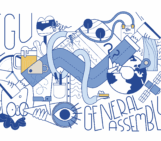
It is the new year and new resolutions draw you onward. Yet motivation is fickle, and too often good intentions wither before bearing fruit. You may have drawn a plan to keep you in check, but how do you build on this to achieve sustainable growth?
Sustainable growth has been a crucial throughout my career: from projects management and scientific research to building a charity, all required the ability to identify development pathways. This also applies to my personal life, both as an amateur bodybuilder and someone with AuDHD and bipolar. In this article, I’ll summarise how you can build on your plan to nurture growth.
If you want to know how to plan for change and build momentum, check out the previous blog in this series on how to approach making a change.
Your capacity is shaped by your needs
Increase your capacity through sustainable progress. Capacity is your ability to successfully manage your affairs. It is generated by your individual ability, such as knowledge and skills, and how well your environment enables you to execute your abilities. Increasing your capacity means improving you ability to sustainably achieve an outcome, or to better understand and deal with a particular need. It doesn’t come from just pushing yourself harder.
Be honest with yourself about what you can do. Making a change means challenging your current mind-set, habits and interests. Being frank about what you can and, importantly, cannot do is necessary to understand your capacity. Low capacity is not an argument to stop, but a recognition of your needs at that given time. In periods of low capacity, adjust your tasks to a sustainable level otherwise you will risk burnout and your progress will halt. Whether by a shuffle or a stride, you still move forward.
Support your capacity by changing your environment. Often, a heavy workload can mean domestic duties suffer, but both your work and home environment can shrink or grow your capacity. Consider your environment like that of an household pet – is it comforting? Is it organised? Is it enriching? As much as a pet can be stressed by a messy environment, so too are we stressed by an unstable environment. Your environment supports your success, so consider what you can change to help it do so.
Personalise your approach
Do what works for you. Forcing yourself to adopt methods, activities or values which oppose your needs will undermine your confidence and your ability to achieve. Others may achieve a similar goal a different way to you: this is normal. As someone with AuDHD, I often understand what needs to be done but often cannot execute them in the same as someone without AuDHD might. This often leads to me approach a task in a way that others might not understand. This does not matter: what does matter is whether the task has been accomplished.
Do what you can with what you can do. None of us start from a blank slate, instead we bring our own skill-set and knowledge base. Think about you you can use your current skill-set, capabilities and experience to abet your goals. This might draw on your ability to research online, organise your tasks, or break-down complex information into something comfortable, for example.
Manage your expectations
Accept that you will make mistakes. Paralysis is produced by perfectionism. It is impossible to know everything when starting a project, and so it unrealistic to expect that we do things in a perfect manner. Inevitably, there are known unknowns and unknown unknowns which reshape your strategy as they manifest. Accept that you’ll make mistakes, and that this is needed to refine your progress; there’s no learning without a learning curve.
Focus on iterating on what works and building as you go. There’s a way to do things correctly and there’s a way to get things done – these are not always aligned. As much as writing has an editing stage or programming has a debugging stage, so much of what you are doing can be improved upon later.
Take time to reflect on your achievements. As you move forward so do you keep raising the bar; the standard to which you keep yourself. This risks a lack of a sense of achievement or satisfaction as you chase progress, contributing to a loss of momentum. Take time to reflect on the bigger journey. This will help you track your progress, manage you expectations, and acknowledge what you have achieved so far.
Be accountable to yourself.
Your strategy is only useful if it is usable. Keeping yourself accountable is key for making any change, and this means providing time to reflect on positive and negative outcomes. Always keep your reflections practical:
- What worked?
- What could have been better?
- What supported you?
- What can be done to make a positive change?
- What were you thinking when you originally set your goals?
- How have your needs changed in the time since?
Don’t succumb to negativity bias. One of the great parasites of personal development is negativity bias. Searching for and dwelling on negative comments, for example, is a common and disheartening past-time. This is because the negative comments feel validating, as if confirming something within us. In its twisted way, it provides answers to the uncertainty our brain fights to resolve. This is negativity bias, and it is something that must be actively worked with lest it lures you off course with its siren call of compelling yet ultimately unrealistic thoughts.
Cultivate positive, and generous, thinking. Incorporating positive thoughts is easily avoided as it feels artificial, yet it is an important part of working with negativity bias. If you find yourself caught in a cycle of negative thinking, know that you should be investing in building-up cycles of positive thinking to counter it.
Be an observer to your thoughts and emotions. As someone with bipolar disorder, I need to be vigilant about my mood fluctuations. Practicing being an observer to my internal self helps me recognise the triggers which pull forth negative thoughts and emotions. When they do come, consider your thoughts and emotions like watching a leaf floating on a stream until it is out-of-sight: acknowledge it, but resist the urge to do something with it or attach to it a story which it doesn’t deserve.
Schedule time to reflect. It is easy to be mindful but it is difficult to remember to be mindful. Approach mindfulness and emotional intelligence as you would with developing any other skill, like learning a language or how to code: book a regular time and day in your calendar to reflect, and decide how you’re going to approach it. One popular, and scientifically supported, approach is gratitude journaling.
Identify your biases.
Your biases paint meaning where it is not needed. Recognise that your observer-self is itself composed of thoughts and emotions. Always keep in mind that you’re still colouring your thoughts with bias as you sit back and reflect. Acknowledge that we justify our feelings after-the-fact: we reason with ourselves to convince our reactions are typical and logical, but this is itself a bias. The key take-away: resist the desire to add meaning where there is none.
Use intuition like a tool. Your intuition is a mental heuristic – a decision-making short-cut – which is trained on your day-to-day experiences. This means intuition is often inappropriate for processing new information and experiences. This results in the uncomfortable feeling of cognitive dissonance, which asks you to reject new information because it doesn’t feel intuitive. Yet, this can result in the rejection of new information which could otherwise enhance or renew our perspectives. Instead, consider new information critically. You must use the correct tool for the correct job and intuition is not a universally-appropriate tool, even if it wants you to feel that it is.
Be accountable to others.
Build a network of like-minded individuals. Other people are a source for inspiration and learning, but it also encourages you to commit to your project by imposing external accountability; we’re social creatures, and we can use that to our advantage.
Find an approach that works for all of you. Experiment with different approaches to keep your network accountable. This could include scheduling a time to check-in on each other, work in collaborative spaces, or organise a writing retreat, for example. My favourite approach is by hosting hobby dates, or “parallel play” sessions, where you inhabit the same space whilst working on your goals. You don’t have to work on the same project, and it doesn’t have to be a physical space – be it at your kitchen table or by streaming online, both work.
Rest well to work well
Schedule your breaks. In the maelstrom of activity, it can be easy to pass over breaks in the pursuit of progress. This is only borrowing energy from the future which you will have to pay back. Scheduling when you won’t be working is as important as scheduling when you will be. Rest is not only important for recovery and avoiding burnout, but it also provides your subconscious time to process your challenges – sometimes my best ideas manifest when I’m doing something else unrelated to a project.
Incorporate moments of joy. Work can be arduous, and discipline cares not for how you feel but what you do. We are emotional creatures nonetheless, and we should acknowledge this when we manage ourselves. Consider bread-crumbing smaller breaks and moments of joy throughout your routine to ease tedium. A popular approach is the Pomodoro technique, which includes working for 20 minutes followed by a 5 minute break. Ensure these breaks spark joy—whether it’s a cup of tea, a moment in the sun, or a message to a friend.



